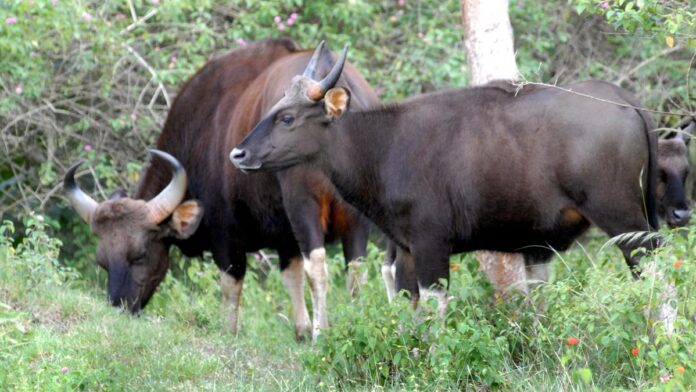
Chain reaction: The outbreak had severe consequences not only for the gaurs but also for the entire ecosystem of Mudumalai. The gaurs help to prevent the overgrowth of certain plants. Their decline disrupted the food chain.
| Photo Credit: FILE PHOTO
In 1968, a deadly outbreak of rinderpest, a highly contagious viral disease, also known as cattle plague, swept through the Mudumalai Wildlife Sanctuary in Tamil Nadu. The outbreak devastated the sanctuary’s gaur population, killing dozens of these majestic wild cattle native to the Western Ghats. Rinderpest primarily affects cattle, buffaloes, and certain wild ruminants. It spreads rapidly through direct contact with infected animals and contaminated environments. It is marked by symptoms such as high fever, nasal discharge, and diarrhoea. By the summer of 1968, rinderpest started affecting the wildlife of Mudumalai, which was home to large populations of gaurs, elephants, and other species. The disease was particularly devastating to the wild herbivores of the sanctuary. The outbreak quickly worsened from isolated cases to an epidemic that killed over 100 buffaloes and at least 40 gaurs by mid-August.
Steady spread
As D. Pattabiraman, a retired Director of Animal Husbandry, explained in The Hindu in 1965, rinderpest is a disease that spreads in a steady, gradual manner, with death occurring over two to three weeks. Its impact on livestock was so severe that it led to the formation of the India Cattle Plague Commission as early as 1869, tasked with finding ways to protect the livestock. By the early 20th Century, the rinderpest mortality figures were staggering. Pattabiraman noted that over 1,50,000 head of cattle succumbed to the disease during 1908-1909, and similar figures were reported during 1918-1919 and 1928-1929. The disease’s cyclical nature — flaring up roughly every decade — showed its potential to wreak havoc on the cattle population. However, significant progress was made in controlling rinderpest after compulsory inoculation was introduced in 1929. This method became widely accepted after people witnessed its success in preventing the disease, despite the difficulty in securing the vaccines.
Yet, as the Mudumalai outbreak in 1968 demonstrated, the challenge remained particularly acute for wild ruminants. While domestic cattle populations had been better protected, thanks to government-led vaccination programmes, wild populations like the gaurs in Mudumalai were not so fortunate. In fact, Pattabiraman’s report highlighted that rinderpest remained a persistent threat to both domestic and wild herds in India, with a devastating effect in unprotected areas.
M. Krishnan’s concerns
For M. Krishnan, one of India’s leading naturalists, the outbreak was deeply troubling. He had spent years observing the wildlife of Mudumalai and was familiar with the sanctuary’s ecosystem. He had long called for stronger measures to manage wildlife habitats, especially measures against the threat posed by diseases that could spread from domestic animals to wildlife. His concerns about the dangers posed by domestic cattle to wild animals were recorded by historian Ramachandra Guha in his book Speaking with Nature: The Origins of Indian Environmentalism. In his profile of Krishnan, Guha captured the naturalist’s worries about how the presence of domestic cattle — particularly in sanctuaries like Mudumalai — posed a serious threat to wild herbivores, exposing them to devastating diseases.
Krishnan had first raised the alarm in 1966 when the foot-and-mouth disease spread from cattle to wild herbivores in the sanctuary. He urged the authorities to ban cattle from the preserve. His advice, however, went unheeded, and the rinderpest outbreak in 1968 served as a painful vindication of his concerns. In the aftermath, Krishnan lamented the tragic loss of the gaurs, a species he had long admired, and noted how domestic cattle not only served as disease vectors but also competed with wild herbivores for resources. He emphasised the need for stricter controls on cattle in protected areas. His observations contributed to a broader understanding of the challenges faced by wildlife sanctuaries in India.
Outbreak’s impact
The outbreak had severe consequences not only for the gaurs but also for the entire ecosystem of Mudumalai. As large herbivores, gaurs play a vital role in shaping the vegetation of the forest. By browsing on grasses and shrubs, they help to maintain the landscape and prevent the overgrowth of certain plants. Their decline disrupted the food chain, affecting smaller herbivores that relied on similar vegetation. With fewer gaurs, certain types of grasses flourished, altering the plant community and further impacting the balance of the sanctuary’s ecosystem. The decline of this important species also affected the predators and scavengers that relied on gaurs as prey.
Response
The wildlife officers of Mudumalai worked to contain the spread of the disease. Forest Department workers searched for carcasses and disposed them of quickly to prevent further contamination. However, in the absence of the resources or scientific knowledge to combat rinderpest in wild animals, their efforts were limited. As E.R.C. Davidar, naturalist and wildlife conservationist, noted in The Hindu on November 10, 1968, the outbreak exposed the serious weaknesses in India’s wildlife management policies. He said that while more sanctuaries were being created, few had the proper infrastructure or scientific support to manage emergencies. He advocated for a more proactive approach towards wildlife management, organised responses to epidemics, and better integration of veterinary care for wild species. He also highlighted the importance of creating stronger boundaries for sanctuaries to prevent the spread of diseases from domestic animals.
Published – November 21, 2024 10:57 pm IST
